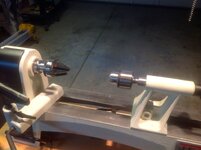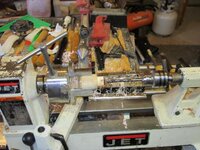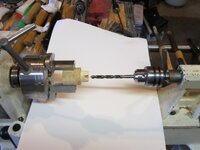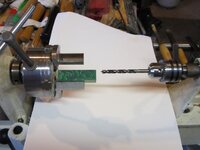Chris
Here's the list of items that I think are useful in drilling on the lathe:
1. A jacobs chuck with an MT arbor that matches your lathe. A jacobs chuck holds drill bits and is usually mounted in the tailstock of your lathe and is stationary, while the workpiece is mounted on the headstock and is rotating. You will have two choices to make when purchasing a jacobs chuck -
a. 1/2" vs 3/8". The 1/2" will be more expensive, but far more versatile. Bits larger than 1/2" tend to come in the 'Deming & Silver' design (reduced diameter shank), so a 1/2" bit can be used for almost any size bit you might need. But if you go cheap and get a 3/8" chuck, you might encounter difficulty if you ever need to drill holes in the 3/8 - 1/2" range.
- keyed versus keyless. Keyless is popular, and there is an argument that it is safer on a lathe (you can't leave a key in the hole where it can get slung into your face if the chuck starts rotating unexpectedly). Keyed is usually less expensive. But another factor is that I have been told, and my experience tends to support this, that it is easier to line a bit up properly in a keyed chuck than in a keyless chuck. So my preference is for keyed.
2. A scroll chuck to hold the workpiece on the headstock. Here, there are options between brands - obviously, the better brands are more expensive, but the less expensive brands may work just fine. The one functional choice is between a crank or tommy bars. Crank-style chucks are more expensive, and what you get for the premium is convenience. I opted for a less expensive tommy bar chuck and I've been quite satisfied with it.
3. Jaws to hold the workpiece. The purpose of jaws is to hold the workpiece in the chuck, and a key requirement is that the jaws must hold the axis of the workpiece on the axis of the lathe while you are drilling. You can purchase special pen drilling jaws that do that very well - these are deep (the deeper the better) and hold the workpiece on opposing corners. I don't have pen drilling jaws, and my experience is that ordinary #1 or #2 jaws are adequate PROVIDED you put the blank between centers and turn a tenon on one end before you mount it in the chuck. Yes, that's an extra step. Having pen drilling jaws means you may be able to skip that step. So what it comes down to is whether you expect to do production turning where saving a few steps is important. By the way, you must purchase jaws from the supplier of your chuck - they aren't interchangeable.
4. Drill bits. This is where the money starts to add up. There is no one single perfect bit. Here's what I have:
- a set of center bits. These are short, stiff bits with tapered ends that are used to find the center of the blank and start the hole. I bought mine at Harbor Freight where they are relatively inexpensive. They may not be the best, but they are good enough if all I am going to use them for is starting holes in wood.
- a set of jobber-length twist drill bits. I bought a large set at Harbor Freight - the full range of fractional bits from 1/16 to 1/2" in 1/64" steps, as well as the lettered bits and the wire gauge bits from 1 to 60. I opted for standard high-speed steel because I expect to be using them only in wood.
- a few 'aircraft style' twist drill bits. These are longer length bits (typically 6-7") that are used when drilling very deep holes. You don't need these often, so I suggest only buying something if you have a specific need.
- a set of brad-point bits from 1/8" to 1/2" that I bought at Home Despot. I tend to use them more on the drill press than on the lathe, but they are good to have.
- a few metric brad-point bits (7mm, 10mm) that I bought to go along with specific pen kits
- a set of spade bits ranging from 1/4" to 1 1/2". I don't use these all that often, but they are useful in hogging out material prior to hollowing. I think the basic set came from Sears, but I've added a few odd sizes along the way. They drill fast, but leave a rough hole with a deep divot in the end.
- a set of forstner bits ranging from 1/4" to 1 1/2". I bought the set at Lowes, but have been adding odd sizes along the way that I've picked up at garage sales and flea markets. Forstner bits drill very slowly, but leave fairly clean holes with a pretty flat bottom.
- a fine grit diamond hone paddle. Drill bits get dull and you have to tune up the cutting edge frequently. You can buy an expensive Drill Doctor (on my wish list), but you can do a pretty good job with a small diamond hone.
- a block of ordinary grocery-store canning paraffin that I use to lubricate deep holes. Just rub the block on a warm bit to pick up enough of the wax to do the job. But don't lubricate holes if you expect to glue something in the hole later.
- a small brush to clean the swarf out of the flutes of a drill while drilling. You can use an old toothbrush, but a brass or stainless steel brush is better. I embedded a rare earth magnet in the handle of the brush so that it can live on the end of my lathe bed where it is always convenient.
5 A drawbar to hold the jacobs chuck on those occasions when you mount it in your headstock. This is something you have to make yourself from a length of all-thread rod (choose the diameter that matches the threading in the end of the chuck arbor), and then make a handle to go on the end. There are a number of YouTube videos on making drawbars. You won't mount the jacobs chuck on the headstock often, but when you do, you MUST have a drawbar.




